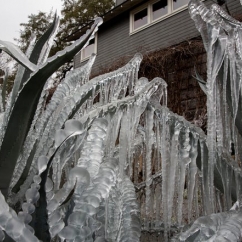Articles and News
Jewelers Need To Prepare For Cold Weather, Too February 17, 2021 (0 comments)

New York, NY—Between ordinary security and doing business in a pandemic, jewelers may feel they have enough to worry about. Unfortunately, the arctic blast bringing abnormally cold temperatures to many parts of the country can also spell a lot trouble for jewelers, too. In addition to power outages that threaten a jeweler's security system, frozen water pipes or sprinkler systems in the store, or ice dams on the roof, can cause tremendous damage and inconvenience. Image: Austin American-Statesman
In the event of a power outage, the Jewelers' Security Alliance advises jewelers to follow these tips:
- Alert police immediately and only go to the store accompanied by police. JSA president John Kennedy advises jewelers forge a good, supportive relationship with their local police departments to ensure reciprocal support.
- Do not let either the police or your alarm company automatically brush off a power outage as accidental or weather-related. Although it may well be in this situation, cutting power to a jewelry store has been a popular MO for thieves in a recurring pattern across the country as well.
- Make sure your alarm company has a robust call list so that someone from the store will be available at all times in case of emergency.
Berkley Asset Protection shared these tips from the Insurance Institute for Business & Home Safety for preventing burst pipe and water damage:
- Provide a reliable back-up power source, such as a stand-by generator, to ensure continuous power to the building.
- Interior building temperature can be monitored by a central monitoring company to ensure prompt notification if the interior of the building reaches low temperatures after hours or during power outages or idle periods.
- To prevent the release of heat into the attic, insulate recessed light fixtures in the ceiling below the open area that is directly under a roof, such as attic space. Check to see if there is any visible light from recessed light fixtures in the attic. If there is visible light, the lighting fixtures are not adequately sealed or insulated. Sometimes, especially in low-sloped roof buildings, the space above a suspended ceiling located below the roof may be heated and cooled like the occupied area below. If that is the case, there is no need to insulate above the suspended ceiling or seal the ceiling's penetrations.
- Insulate all attic penetrations such as partition walls, vents, plumbing stacks, electric and mechanical chases, and access doors that are not properly sealed.
- Ensure proper seals on all doors and windows. You may want to conduct a basic building pressurization test to increase infiltration through cracks and leaks, making them easier to detect.
- Seal all wall cracks and penetrations including domestic and fire protection lines, electrical conduit, other utility service line, etc.
- Sprinkler systems should be monitored by a constantly attended central station to provide early detection of a sprinkler pipe rupture due to freezing.
- Insulation and/or heat tape with a reliable power source may be installed on various wet sprinkler system piping. This includes main lines coming up from underground passing through a wall, as well as sprinkler branch lines.
- UL-approved gas or electric unit heaters can be installed in unheated sprinkler control valve/fire pump rooms. If back-up power is provided, the heaters should also be connected to this power source.
- A monitored automatic excess flow switch can be placed on the main incoming domestic water line to provide early detection of a broken pipe or valve when the space is unoccupied.
- Seal gaps in windows and doors with caulk. Note: Taping glass does nothing to address the main point of protection, keeping the glass intact.
Tips for preventing ice dams include:
- Keep snow from accumulating on the lower three to six feet of your roof (if it’s slanted).
- Keep the attic well ventilated so snow doesn't melt and refreeze on the roof's edge.
- Make sure the attic floor is well insulated to minimize the amount of heat rising.
- Consider having the snow (professionally) removed from your roof.
- Make sure your gutters are clear of leaves and debris.
- When all else fails, install heat cables on the roof. Heat cables are high-resistance wires that you mount on the roof edge in a zigzag pattern and plug into an outdoor GFCI receptacle.







